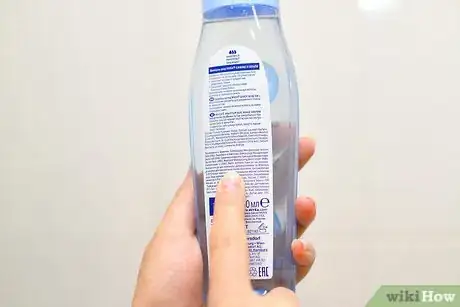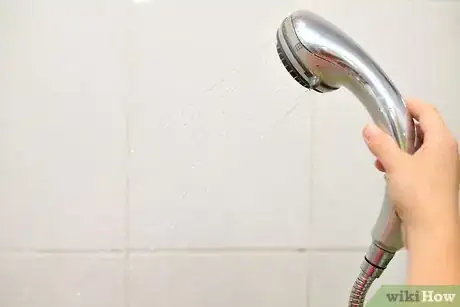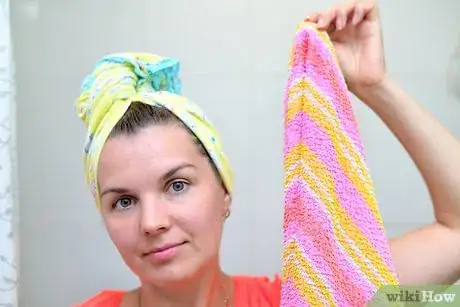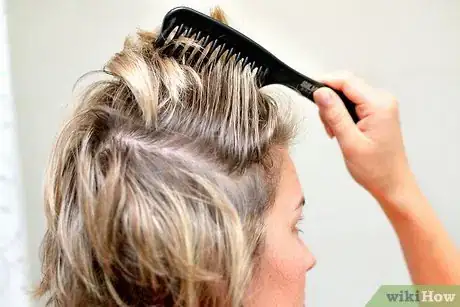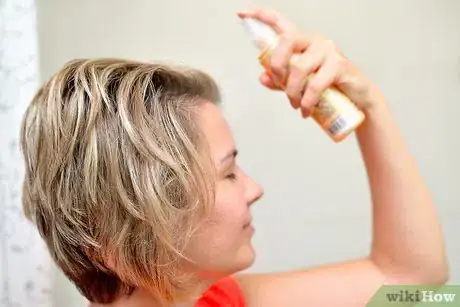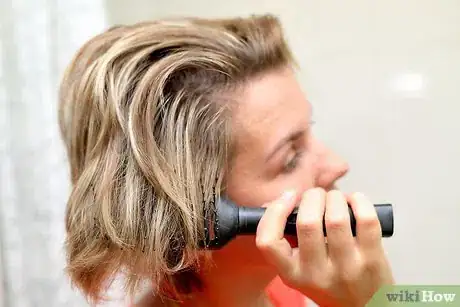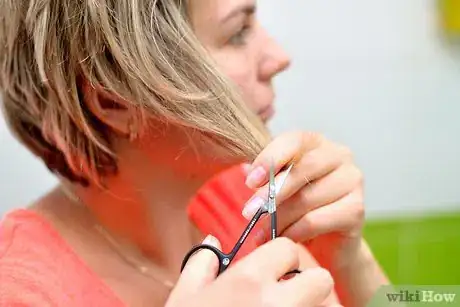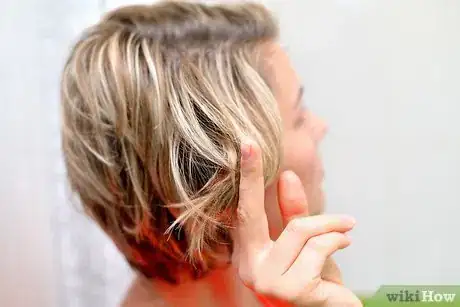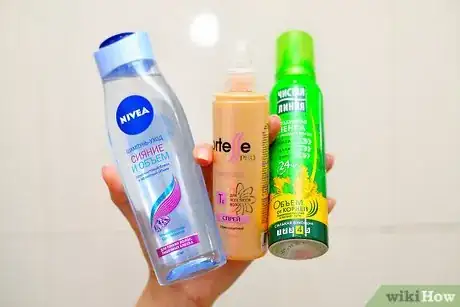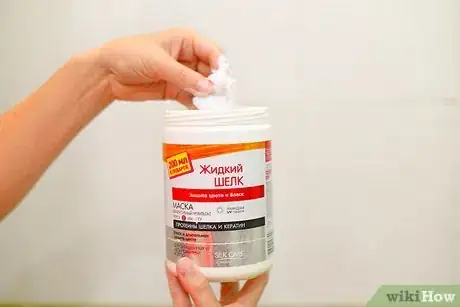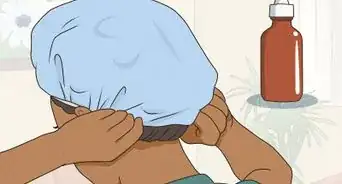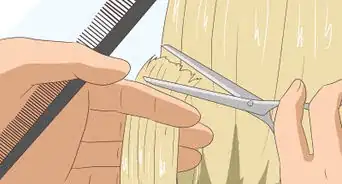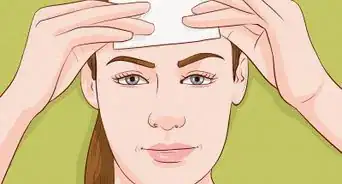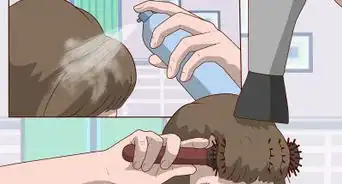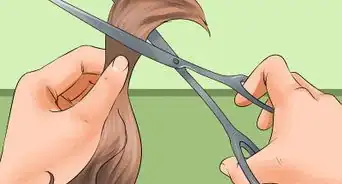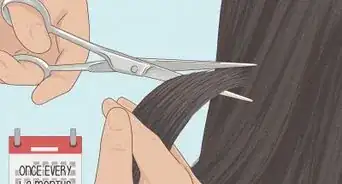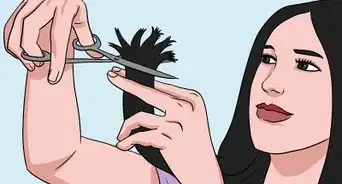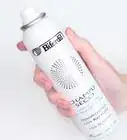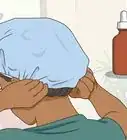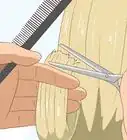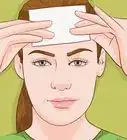This article was co-authored by Martin Nepton and by wikiHow staff writer, Amber Crain. Martin Nepton is a Professional Hair Stylist and Colorist at Bang Bang LA in Los Angeles, California. With over 11 years of experience, Martin specializes in helping clients express their Queer identity through hair. Martin offers personalized haircuts and color and style services with non-gender prices based on hair length. Martin holds a BA from the University of Québec at Montréal and is a Licensed Hair Stylist in California.
There are 8 references cited in this article, which can be found at the bottom of the page.
This article has been viewed 141,937 times.
Most frizz is caused by a lack of moisture in your hair. Dry strands become porous, and frizz occurs when your hair attempts to absorb moisture from the humid air around you. During this process, the hair shaft swells and kinks up, which appears as frizz. Keeping your hair well-hydrated will prevent this from happening. Unfortunately, wavy hair tends to become dehydrated faster than other hair types. The key to combatting frizz is keeping your hair hydrated and locking that moisture into the strands. Using hydrating products and the proper tools can help you keep frizz under control.
Steps
Shampooing and Conditioning Wavy Hair
-
1Shampoo and condition with sulfate-free products.[1] Sodium laureth sulfate and sodium lauryl sulfate are common ingredients in shampoos and conditioners, but sulfates can damage hair and cause frizz. If your current products include these ingredients, replace them. Look for new products that list glycerin as one of the top ingredients, since glycerin can deeply hydrate and protect your hair. Avoid shampoos that advertise as “clarifying” – these will strip moisture from your hair.
- Check product labels for words like “smoothing,” “moisturizing,” and “frizz-reducing.”
- Look for hydrating ingredients like Argan oil, keratin, avocado oil, vitamin E, Moroccan oil and coconut oil.[2]
- Avoid hair products, including shampoos, conditioners, gels, and hairsprays, that contain alcohol, which can dry out and damage your hair.
-
2Use a deep conditioner after every shampoo. Wavy hair requires more moisture than straight hair to combat frizz. After shampooing, apply a rich deep conditioner for a boost of hydration. Don’t skimp on the conditioner – apply plenty of it. Then run a wide-toothed comb through your hair to distribute the conditioner evenly. Leave the deep conditioner on for at least five minutes.[3]
- Look for deep conditioners that contain ingredients like shea butter, glycerin, coconut oil and Argan oil.
- If your hair gets weighed down too much by deep conditioner, avoid applying it to your roots. Try applying it from the mid-shaft down to the ends.
- This is also a great way to detangle your hair.
Advertisement -
3Rinse out the conditioner with cold water.[4] Cold water will smooth and close the hair cuticle, which helps to prevent frizz and adds extra shine.[5] Right before you get out of the shower, rinse what’s left of the conditioner out of your hair with the coldest water you can tolerate. Avoid using the wide-toothed comb during the rinse, since at this stage it can damage your strands.
-
4Avoid terrycloth towels.[6] Terrycloth fibers cause friction on hair strands, which creates frizz. Switch from terrycloth bath towels to microfiber towels for your hair. Microfiber towels absorb water better and faster than traditional terrycloth towels, and they don't disrupt the hair's natural wave. Flip your hair upside down, wrap it in the microfiber towel and gently squeeze the water from your hair.
- Start at the roots and work your way down to the ends.
- Be gentle with your wet hair. Never rub at or use rough motions on your hair with a towel, which will disturb the hair cuticle and create frizz.
-
5Allow your hair to air dry 90 percent of the way before blow drying.[7] Blow drying wet hair can damage it and cause significant amount of frizz. Blow dryers focus a lot of hot air on your strands and this will dehydrate your hair, especially if you live in a dry climate or during the winter when there’s less humidity in the air.
- Let wavy hair air dry 90 percent of the way and then use your blow dryer to dry the remaining 10 percent.
Choosing the Right Products and Tools
-
1Use a wide-toothed comb on wet hair.[8] After washing your hair, never use a regular hairbrush on it. This will cause a lot of breakage. Instead, use a wide-toothed comb to gently detangle your strands. If you don’t have a wide-toothed comb when you get out of the shower, use your fingers to comb through your hair. A wide-toothed comb can help you separate your waves and define your hair style, as well.
- Use a wide-toothed comb in the shower to evenly distribute conditioner through your hair.
- If you use any hair products on wet or damp hair, use a wide-toothed comb to disperse them evenly.
-
2Invest in a high-wattage ionic blow dryer.[9] The heat and ionic technology work hand-in-hand to cut drying time in half and seal the hair cuticle so that it lays down flat. A sealed, flat hair cuticle will never look frizzy. Use the blow dryer on its medium heat setting. Avoid the high setting, which will make the hair cuticle swell. Try to get an ionic blow dryer that is at least 1800 watts.
- Don't shut off the blow dryer until hair is completely dry.
- Don’t blow dry your hair in the bathroom. The steam from your recent shower creates a humid, frizz-inducing environment. Do it in another room or wait until the bathroom has returned to a normal temperature.[10]
-
3Buy a smoothing serum.[11] Smoothing serums combat dry and frizzy hair by smoothing out the hair cuticle, forcing it to lay down flat.[12] Serums also create shine and protect your hair from environmental damage. These products should be applied to damp hair right before blow drying. A tiny drop of serum can tame fly-aways and frizz on dry hair, too.
- Invest in a smoothing serum that lists Argan or Moroccan oil in the ingredients. These hydrating ingredients will provide frizzy hair with an added dose of moisture.
- Make sure your serum doesn’t have alcohol listed as an ingredient. Alcohol is drying and damaging, which creates frizz.
-
4Get a brush with a mix of boar and nylon bristles.[13] Boar bristles help distribute natural oils from the scalp to the ends of your hair. This natural oil, called sebum, deeply hydrates the hair shaft, which can drastically reduce frizz. The nylon bristles help to detangle your hair gently while the boar bristles moisturize it by distributing the sebum. Brush from root to tip with each stroke to properly distribute the oils.
- Immediately after you brush wavy hair with boar bristles, it will probably puff up a bit. Gently twist your stands, which will relax them and they'll smooth out naturally.
Maintaining Frizz-Free Hair
-
1Get regular haircuts.[14] If you haven’t had a haircut in a few months, you probably have split ends. This is normal. However, split ends can cause a lot of frizz. Get your hair trimmed every six to eight weeks to avoid splitting and breakage. Book your appointments well in advance so that you won’t forget.
-
2Sleep on a satin pillowcase.[15] Cotton bed linens create friction during the night as you toss and turn. This friction causes frizz, along with tangles, breakage and split ends. Satin has a much smoother texture, so sleeping on a satin pillowcase will reduce the friction that causes frizz. Satin also helps hair maintain moisture, which helps combats frizz.
- Cotton and other fabrics tend to dry the hair out.
- Wrapping your hair in a satin or silk scarf before you go to sleep will provide the same benefits as the satin pillowcase.[16]
-
3Avoid touching your hair during the day.[17] Tousling and running your fingers through your hair causes frizz because it disrupts the smoothness of the hair shaft. The more often you touch your hair throughout the day, the frizzier it will become. Whenever possible, avoid touching your wavy hair to maintain your smooth style.
-
4Reduce hair washings.[18] Natural oils from your scalp smooth and moisturize your hair, which prevents frizz. Shampooing frequently strips your hair of those natural oils. Whenever possible, wait at least two days between shampoos. This will give your scalp time to create more natural oil. Four shampoos every week should be enough. On the days when you don’t shampoo, rinse it and then apply conditioner as you normally would. You can also use dry shampoo in between regular washes.
- If you have fine hair, you probably need to shampoo every other day.
- If you have very thick hair, you can probably go three or four days without shampooing.
-
5Use a deep-conditioning mask once per week.[19] Wavy hair tends to get dehydrated fast, which makes it prone to frizz. A weekly deep-conditioning mask can help to rehydrate your dry strands by delivering a large dose of much-needed moisture. These masks will also keep hair feeling soft and restore damaged hair cuticles.
- Look for deep-conditioning mask products that contain glycerin, proteins, shea butter and other hydrating ingredients to prevent frizz.
Expert Q&A
Did you know you can get expert answers for this article?
Unlock expert answers by supporting wikiHow
-
QuestionHow do I stop my wavy hair from frizzing?
 Martin NeptonMartin Nepton is a Professional Hair Stylist and Colorist at Bang Bang LA in Los Angeles, California. With over 11 years of experience, Martin specializes in helping clients express their Queer identity through hair. Martin offers personalized haircuts and color and style services with non-gender prices based on hair length. Martin holds a BA from the University of Québec at Montréal and is a Licensed Hair Stylist in California.
Martin NeptonMartin Nepton is a Professional Hair Stylist and Colorist at Bang Bang LA in Los Angeles, California. With over 11 years of experience, Martin specializes in helping clients express their Queer identity through hair. Martin offers personalized haircuts and color and style services with non-gender prices based on hair length. Martin holds a BA from the University of Québec at Montréal and is a Licensed Hair Stylist in California.
Professional Hair Stylist
-
QuestionHow do I stop my hair from frizzing?
 Laura MartinLaura Martin is a Licensed Cosmetologist in Georgia. She has been a hair stylist since 2007 and a cosmetology teacher since 2013.
Laura MartinLaura Martin is a Licensed Cosmetologist in Georgia. She has been a hair stylist since 2007 and a cosmetology teacher since 2013.
Licensed Cosmetologist
-
QuestionHow do I keep my hair tangle free?
 Laura MartinLaura Martin is a Licensed Cosmetologist in Georgia. She has been a hair stylist since 2007 and a cosmetology teacher since 2013.
Laura MartinLaura Martin is a Licensed Cosmetologist in Georgia. She has been a hair stylist since 2007 and a cosmetology teacher since 2013.
Licensed Cosmetologist
References
- ↑ http://www.cosmopolitan.com/style-beauty/beauty/how-to/a33187/how-to-defrizz-your-hair/
- ↑ http://www.cosmopolitan.com/style-beauty/beauty/how-to/a10362/sleek-strands/
- ↑ http://www.naturallycurly.com/curlreading/frizz-control/15-must-have-essential-no-frizz-tips/
- ↑ http://www.naturallycurly.com/curlreading/frizz-control/15-must-have-essential-no-frizz-tips/
- ↑ Martin Nepton. Professional Hair Stylist. Expert Interview. 17 November 2020.
- ↑ http://www.naturallycurly.com/curlreading/frizz-control/15-must-have-essential-no-frizz-tips/
- ↑ http://www.cosmopolitan.com/style-beauty/beauty/how-to/a33187/how-to-defrizz-your-hair/
- ↑ http://www.naturallycurly.com/curlreading/frizz-control/15-must-have-essential-no-frizz-tips/
- ↑ http://www.allure.com/gallery/frizz-mistakes-to-avoid
- ↑ http://www.allure.com/gallery/frizz-mistakes-to-avoid
- ↑ http://www.huffingtonpost.com/2015/06/15/the-best-hair-serums-dry-frizzy-hair_n_7564398.html
- ↑ Martin Nepton. Professional Hair Stylist. Expert Interview. 17 November 2020.
- ↑ http://empoweredsustenance.com/no-heat-hair-care/
- ↑ http://www.naturallycurly.com/curlreading/frizz-control/15-must-have-essential-no-frizz-tips/
- ↑ http://www.naturallycurly.com/curlreading/frizz-control/15-must-have-essential-no-frizz-tips/
- ↑ http://www.cosmopolitan.com/style-beauty/beauty/how-to/a33187/how-to-defrizz-your-hair/
- ↑ http://www.naturallycurly.com/curlreading/frizz-control/15-must-have-essential-no-frizz-tips/
- ↑ http://www.naturallycurly.com/curlreading/frizz-control/15-must-have-essential-no-frizz-tips/
- ↑ http://www.cosmopolitan.com/style-beauty/beauty/how-to/a33187/how-to-defrizz-your-hair/
About This Article
If your wavy hair often gets frizzy, there are a few ways you can fix it. Look for alcohol and sulfate-free shampoo and conditioners, which won’t dry out your hair as much. Wavy hair needs more moisture than regular hair, so deep condition it after each shampoo and leave it in for 5 minutes to keep your hair hydrated. Only use shampoo 3 or 4 times a week so you don't strip your hair of its natural oils. When you get out of the shower, use a microfiber towel to soak up water from your hair. These won’t make your hair frizzy like regular towels. You can also let your hair air dry 90% of the way to save it from the heat of your hairdryer, then just finish it off with a quick blast. For more tips from our Beauty co-author, including how to brush and comb your hair to reduce frizz, read on!
